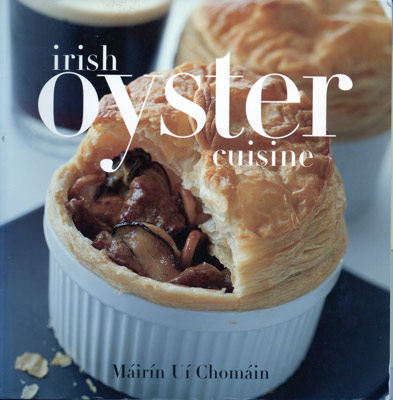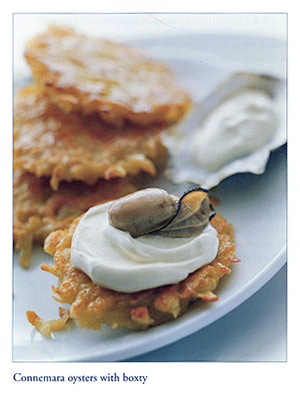A note on Irish Oyster Cuisine by Mairin Ui Chomain (Dublin 2004)
This slight volume is either anachronistic or progressive depending on the context in which it is considered. The Irish have not traditionally had an oyster cuisine; the elites who ate oysters at all, and they are the only Irish people who traditionally ate oysters, ate them raw with few exceptions. In that sense the book is an example of Irish bunkum because, as Ui Chomain admits in an aside: “Now about the book’s cuisine. Again, to give a little more context,” although in fact she has given next to none, “there is precious little written about oyster cooking in Ireland,” which overstates the amount written about oyster cooking there. (Oyster Cuisine 14)

If, however, the book aims to exploit an excellent resource then it may be a welcome addition to kitchens in Ireland and elsewhere. The recipes are simple and clear and, in celebration of the Gaeltacht, written in Gaelic as well as English, an exemplary innovation in the cookbook world. Flann O’Brien could have read either version, along with Ui Chomain herself and Michael Higgins, the elfin president, Irish rarities.
Irish Oyster Cuisine does include some indigenous preparations, but is not in the main particularly Irish, and the Irish elements tend to be accompaniments for oysters rather than recipes for the shellfish itself. Many of the recipes presented as Irish are lifted wholesale from other cuisines and disguised with Irish names.
Louisiana contributes a couple; oyster and artichoke soup and “Celebration oysters” (with spinach and Pernod, straight from Antoine’s) Hangtown fry from elsewhere in the United States does double duty as a “Clarinbridge oyster omelette” and “Kylemore oyster breakfast;” carpetbagger steak gets misdescribed as “Roscam oysters.” “Kevin’s oyster pie” is the recognizably English steak and oyster pie dating from the eighteenth century.
A particularly puzzling proposition; “Galway Blazer oysters.” With eighteenth century antecedents, the Galway Blazers, formally the Galway Hunt Club, are one of the older hunt clubs in Ireland. The club holds point to point meetings as well as riding to hounds for fox hunts and throws an annual hunt ball. Among her many other activities the redoubtable Lady Mollie Cusack Smith, the first and only Master of Hounds (for forty years) at the nearby North Galway Hunt kept the pack together during the lean years of the ‘Emergency’ during World War Two and otherwise dominated social life in North Galway for decades. Neither the blazers nor she, however, has an association with curry or curried oysters, that is, Ui Chomain’s Galway Blazers.
Ui Chomain presents oysters in béchamel, hollandaise and mornay sauces as somehow Irish, and tries to turn generic combinations like red cocktail sauce, which never, ever should approach let alone encounter an oyster, oyster shots and bloody marys green. A blini apparently belongs to a Diarmuid and Mike makes oysters eastern Irish style, in tempura sauced with a suspension of soy, mirin and chili oil.
It is all a bit silly except for the sort of actually Irish bits. Boxty is good with almost anything savory but has no particular association with Connemara; a tower of apple fried with honey and black pudding capped by an oyster is inspired, although the capstone itself would be better raw than fried.

True to the national tradition, a lot of frying transpires in Irish Oyster Cuisine. A lot of the dishes in Oyster Cuisine pair them with sausages, to good, and as far as we know, original effect. There is a sort of oyster Scotch egg in which an oyster replaces each egg. It is risibly called a bouchee, which Merriam Webster explains is a small pastry encasing a creamy rather than briny element, but never mind the name; the snack is a good one, “dream finger food” as Ui Chomain attests. She might, however, have refrained from padding Oyster Cuisine by repeating the recipe, with and without pairing it with colcannon cake.
Then again raw oysters with warm little ‘cocktail sausages’ (chipolatas in England and, we thought, in Ireland too) is not a recipe at all and the accompanying red cocktail sauce does nothing for either of its partners. One hit, one miss; not bad for baseball but a little uneven for the cook but on balance a handy if bemusing little book.
